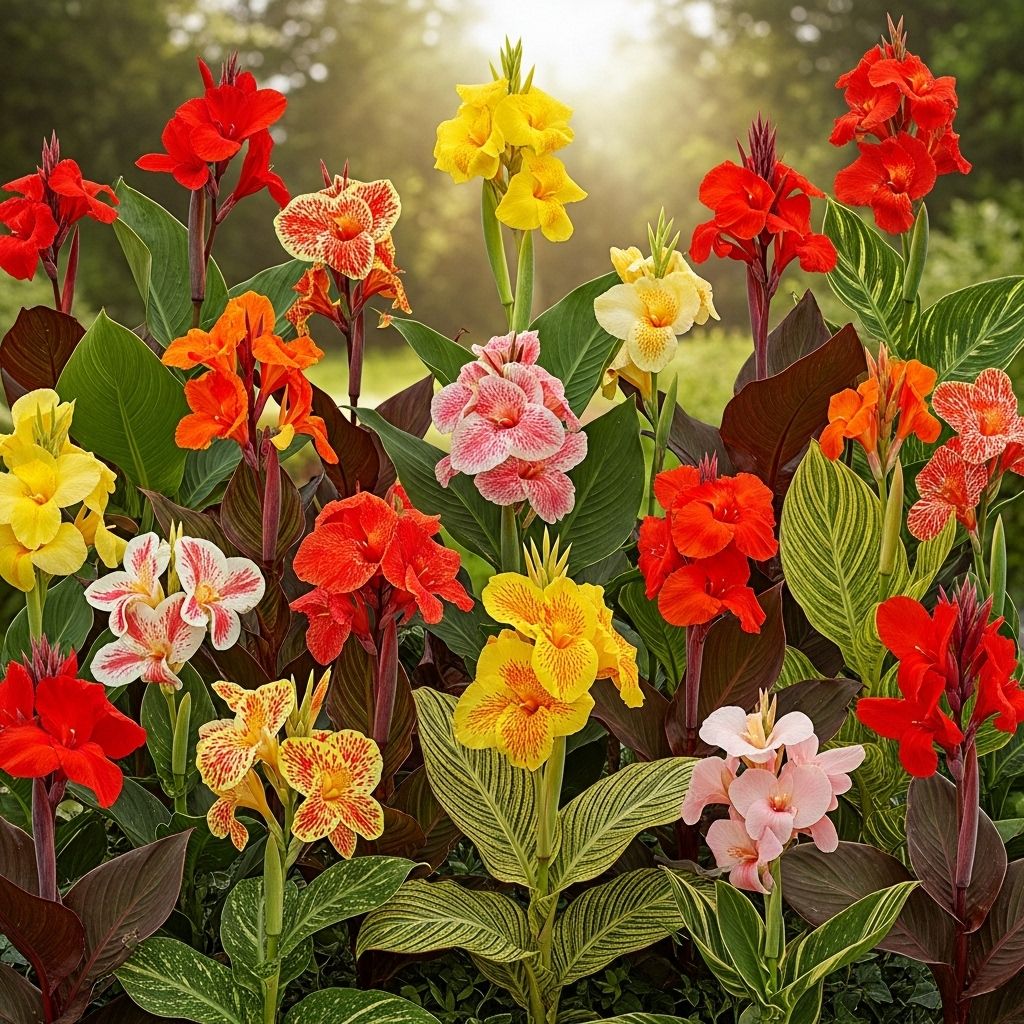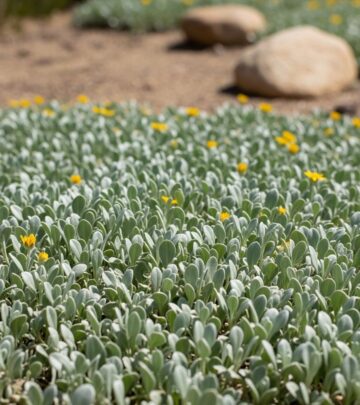Canna Lily Varieties: 21 Spectacular Picks For Your Garden
Discover the most stunning canna lily varieties to transform your garden into a tropical paradise

Image: HearthJunction Design Team
Canna lilies are among the most dramatic and rewarding plants you can grow in your garden. With their bold foliage and vibrant blooms in shades of red, orange, yellow, pink, and creamy white, these tropical-looking beauties add an exotic touch to any landscape. Despite their name, cannas aren’t true lilies at all—they belong to their own family, Cannaceae, and are more closely related to gingers, bananas, and birds of paradise than to lilies.
These versatile plants originate from the American tropics but have been naturalized worldwide. Today’s gardeners can choose from hundreds of cultivars with various heights, flower colors, and foliage types. In this comprehensive guide, we’ll explore the most spectacular canna lily varieties and provide expert advice on growing and caring for these stunning plants.
Understanding Canna Lilies
Before diving into specific varieties, it’s helpful to understand what makes canna lilies such special garden plants. Cannas are rhizomatous perennials that grow from underground stems called rhizomes. They belong to a genus consisting of 10 species, all native to tropical and subtropical regions of the Americas.
What makes cannas particularly valuable in the garden is their dual ornamental appeal—they offer both spectacular flowers and impressive foliage. The large, paddle-shaped leaves come in various colors, including green, burgundy, purple, variegated, and striped patterns. The flowers, while not particularly long-lasting individually, are produced in succession on tall stalks, ensuring a long blooming season typically from summer until the first frost.
Classification of Canna Lilies
Canna lilies are typically classified by height, with varieties ranging from dwarf (under 3 feet) to giant (over 6 feet). They can also be categorized by their primary ornamental feature—either their flowers or their foliage. Understanding these classifications can help you select the perfect variety for your garden needs.
Height Classifications
- Dwarf Cannas: 1.5 to 3 feet tall, perfect for containers and garden borders
- Medium Cannas: 3 to 4.5 feet tall, versatile for most garden settings
- Tall Cannas: 4.5 to 6 feet tall, excellent as background plants
- Giant Cannas: Over 6 feet tall, create dramatic vertical accents
Popular Canna Lily Varieties by Flower Color
One of the most appealing aspects of canna lilies is their range of vibrant flower colors. Let’s explore some outstanding varieties organized by flower color.
Red-Flowering Canna Varieties
Red-flowering cannas are among the most popular and create a dramatic focal point in the garden. Their fiery blooms stand out brilliantly against green foliage and complement other hot-colored plants beautifully.
Canna ‘Red King Humbert’ – This classic variety reaches 4-5 feet tall and features deep red flowers with bronze-purple foliage. It’s been a garden favorite for over a century due to its reliable performance and striking color combination.
Canna ‘Red Tiger’ – This unique variety offers cherry red flowers that contrast beautifully with its creamy-yellow and green variegated foliage. Growing to about 3-4 feet tall, it makes a statement in borders and mixed plantings.
Canna ‘The President’ – Considered one of the best red cannas available, ‘The President’ produces massive 4-inch scarlet-red blooms on plants reaching 4 feet tall. Its bright green foliage provides the perfect backdrop for the intense flower color.
Orange-Flowering Canna Varieties
Orange cannas bring tropical warmth to the garden and pair beautifully with blues and purples for a complementary color scheme.
Canna ‘Wyoming’ – This spectacular variety grows 4-5 feet tall with bronze-purple foliage and vibrant orange orchid-like flowers. The combination of dark leaves and bright blooms creates a striking visual impact.
Canna ‘Intrigue’ – Notable for its unique purple-gray foliage, ‘Intrigue’ produces orange-red flowers on tall stems reaching 6-8 feet. This variety makes an excellent vertical accent in the garden.
Canna ‘Pretoria’ (also called ‘Bengal Tiger’) – This variety features stunning green and yellow striped foliage with bright orange flowers. Growing 4-6 feet tall, it’s as prized for its foliage as for its blooms.
Yellow-Flowering Canna Varieties
Yellow cannas bring sunshine to the garden and blend well with virtually any color scheme.
Canna ‘Richard Wallace’ – This classic variety grows 4-5 feet tall with bright green foliage and clear yellow flowers with small red spots in the throat. It’s a reliable performer that lights up the summer garden.
Canna ‘Cannova Lemon’ – Part of the Cannova series developed for earlier and more abundant flowering, this variety offers bright lemon-yellow blooms on compact plants with green foliage, reaching about 3-4 feet tall.
Canna ‘Yellow King Humbert’ – This striking variety produces yellow flowers speckled with red dots on plants reaching 4-5 feet tall. Its green foliage provides a nice contrast to the colorful blooms.
Pink-Flowering Canna Varieties
Pink cannas offer a softer look compared to the bolder reds and oranges, making them versatile for many garden designs.
Canna ‘Pink Sunburst’ – This variety features salmon-pink flowers above variegated green and white striped foliage. Growing to about 3-4 feet tall, it’s as valuable for its unusual foliage as for its blooms.
Canna ‘Erebus’ – Growing 4-5 feet tall, ‘Erebus’ produces soft pink flowers and blue-green foliage. It’s an excellent choice for water gardens as it can be grown in shallow water.
Canna ‘Dawn Pink’ – This compact variety reaches just 2-3 feet tall, making it perfect for containers and small spaces. Its shell pink flowers bloom prolifically throughout summer.
White-Flowering Canna Varieties
White cannas add elegance to the garden and glow beautifully in evening light.
Canna ‘Ermine’ – This refined variety produces creamy white flowers with pale yellow centers on plants reaching about 3-4 feet tall. Its green foliage provides a classic backdrop for the pristine blooms.
Canna ‘White Tiger’ – Notable for its variegated foliage with green and white stripes, ‘White Tiger’ produces creamy-white flowers. Growing to about 3 feet tall, it’s an eye-catching addition to borders and containers.
Canna ‘Stuttgart’ – This variety is primarily grown for its spectacular green and white variegated foliage, though it also produces modest salmon-colored flowers. Growing 4-5 feet tall, it makes a bold architectural statement.
Outstanding Foliage Canna Varieties
While many gardeners choose cannas for their flowers, some varieties are primarily grown for their spectacular foliage. These plants maintain their ornamental value even when not in bloom.
Canna ‘Tropicanna’ (also known as ‘Phasion’) – Perhaps the most famous foliage canna, ‘Tropicanna’ features stunning leaves striped in shades of green, yellow, pink, and burgundy. Its orange flowers are an added bonus on plants reaching 4-6 feet tall.
Canna ‘Cleopatra’ – This unusual variety exhibits chimeral variegation, with random patches of green and bronze-purple on both leaves and flowers. The flowers themselves may be part yellow, part red, creating a fascinating display.
Canna ‘Musifolia’ – True to its name (which means ‘banana-leaved’), this giant variety can reach 8-10 feet tall with massive green leaves resembling those of a banana plant. Its small red flowers are secondary to the impressive tropical foliage.
Dwarf Canna Varieties for Containers
Dwarf cannas are perfect for containers and small gardens, bringing the tropical look to spaces where larger varieties wouldn’t fit.
Canna ‘Tropical Bronze Scarlet’ – Part of the Tropical series, this compact variety grows just 18-24 inches tall with bronze foliage and bright red flowers, making it perfect for containers.
Canna ‘South Pacific Scarlet’ – An All-America Selections winner, this variety reaches about 30 inches tall and produces prolific scarlet blooms throughout the season.
Canna ‘Picasso’ – This petite variety grows 2-3 feet tall with green foliage and unusual yellow flowers edged in red. Its compact size makes it ideal for smaller gardens and containers.
Growing Canna Lilies Successfully
Canna lilies are relatively easy to grow, but understanding their basic needs will help you get the most spectacular results.
Planting and Location
Cannas thrive in full sun, requiring at least 6-8 hours of direct sunlight daily for best flowering. They prefer rich, moist soil with plenty of organic matter. Plant rhizomes 4-6 inches deep and 1-2 feet apart after all danger of frost has passed and soil temperatures have reached at least 60°F (15°C).
Care and Maintenance
Water cannas regularly, keeping the soil consistently moist. These plants are heavy feeders and benefit from monthly applications of a balanced fertilizer during the growing season. Deadhead spent flowers regularly to encourage continued blooming. In fall, after foliage has been damaged by frost, cut stems back to 4-6 inches above ground level.
Winter Care
In zones 8 and warmer, cannas can typically be left in the ground year-round with a protective mulch layer. In colder regions, dig up rhizomes after the first frost, allow them to dry for a few days, then store in a cool, dry place (40-50°F) in peat moss or vermiculite until spring planting.
Creative Uses for Canna Lilies in the Garden
Canna lilies are versatile garden plants with numerous landscape applications:
- Tropical Borders – Pair cannas with other tropical-looking plants like elephant ears, bananas, and coleus for a lush, exotic border.
- Water Gardens – Many canna varieties can be grown in up to 6 inches of standing water, making them excellent additions to pond edges and water features.
- Container Gardens – Dwarf varieties excel in containers on patios and decks, bringing tropical flair to small spaces.
- Cut Flowers – The long-lasting blooms make excellent cut flowers for bold, dramatic arrangements.
Common Pests and Problems
While generally robust, cannas can sometimes face challenges from pests and diseases. Japanese beetles may feed on the foliage, while slugs and snails can damage young growth. Canna leaf roller caterpillars can be particularly problematic, rolling themselves inside leaves and causing significant damage.
Diseases affecting cannas include canna rust, which appears as orange pustules on leaf undersides, and bacterial bud rot, which causes flowers to rot before opening. Good air circulation, avoiding overhead watering, and proper fall cleanup can help prevent these issues.
Frequently Asked Questions (FAQs)
Q: Are canna lilies true lilies?
A: No, despite their common name, canna lilies are not true lilies. They belong to the family Cannaceae and are more closely related to gingers, bananas, and birds of paradise than to true lilies, which are in the family Liliaceae.
Q: How long do canna lilies bloom?
A: With proper care, canna lilies will bloom continuously from mid-summer until the first frost. Regular deadheading helps promote continued flowering throughout the season.
Q: Can canna lilies be grown in pots?
A: Yes! Dwarf and medium varieties are excellent choices for container growing. Use a large pot with good drainage, rich potting soil, and provide consistent moisture and fertilizer for best results.
Q: Do canna lilies come back every year?
A: Canna lilies are perennial in USDA hardiness zones 8-11. In colder regions, the rhizomes must be dug up in fall and stored indoors over winter, then replanted in spring after all danger of frost has passed.
Q: How do I propagate canna lilies?
A: Cannas are typically propagated by division of the rhizomes. In spring, cut rhizomes into sections, ensuring each piece has at least 2-3 growth eyes. Plant these sections to create new plants that will be identical to the parent.
Canna lilies bring unmatched tropical drama to the garden with minimal effort. Whether you’re drawn to their flamboyant flowers or spectacular foliage, there’s a canna variety perfect for your garden. With proper care, these versatile plants will reward you with months of color and an exotic atmosphere that transforms ordinary garden spaces into extraordinary tropical retreats.
References
- https://garden.org/learn/howto/grow/cannas/toplist/
- https://en.wikipedia.org/wiki/Canna_(plant)
- https://www.edenbrothers.com/collections/canna_lily_bulbs
- https://www.missouribotanicalgarden.org/PlantFinder/PlantFinderDetails.aspx?taxonid=264586&isprofile=1&basic=Canna
- https://plants.ces.ncsu.edu/plants/canna-x-generalis/
Read full bio of Srija Burman












